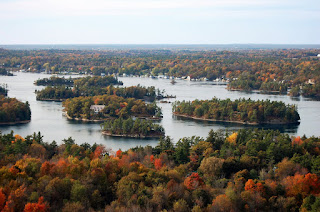 |
| La Ville Souterraine |
2,811 miles
Oct 22 – Montréal
is the largest, most glorious city that I will have passed through on my
transcontinental journey. I cannot
possibly do it justice in a single blogpost.
I found 2 interesting curiosities to explore in the heart of downtown
Montréal.
La Ville
Souterraine (The Underground City) caught my attention because Seattle also has
an underground portion of the city.
The Seattle
Underground is a network of underground passageways and basements downtown that
was at ground level in the mid-19th century. The original Pioneer Square sector had been
built mostly on filled-in tidelands which often flooded, and Seattle's first
buildings were wooden. In 1889, the
Great Seattle Fire destroyed 31 blocks.
 |
| Seattle Underground shop fronts |
Instead of
rebuilding the city as it was before, the city leaders decided that all new
buildings must be made of stone or brick and that the streets should be regraded
from one to two stories (12-30 feet) higher than the original street grade. (The
new street level also assisted in ensuring that gravity-assisted flush toilets
that funneled into Elliott Bay did not back up at high tide.)
 |
Underground Tour guide showing sidewalk skylights,
by Seattle Times artist Gabriel Campanario |
Once the new
sidewalks were complete, building owners moved their businesses to the new
ground floor, although merchants carried on business in the lowest floors of
buildings that survived the fire, and pedestrians continued to use the
underground sidewalks lit by glass prisms embedded in the grade-level sidewalk above.
In 1907, two years before the 1909 World Fair in Seattle (Alaska-Yukon-Pacific Exposition), the
city condemned the Underground for fear of rats and bubonic plague. The
basements were left to deteriorate or were used as storage. Some became illegal
flophouses for the homeless, gambling halls, speakeasies, and opium dens.
After the
streets were elevated, the original ground-level spaces fell into disuse, but a small portion of them were restored and made accessible in the late 20th century, and the guided tours of the Seattle Underground have become a popular tourist attraction.
 |
| La Ville Souterraine map |
In Montreal, La Ville
Souterraine (The Underground City) is a series of interconnected office towers,
hotels, shopping centers, residential and commercial complexes, convention
halls, universities and performing arts venues that form the heart of
Montreal's central business district. Although
the complex was started in 1962 to cover an unsightly pit of railway tracks
north of the Central Station, and vast commercial sectors are located entirely
underground, the Underground City has become more of an indoor city (ville
intérieure) than a truly subterranean place.
The
underground city is promoted as an important tourist attraction by most
Montreal travel guidebooks, and it is an impressive urban planning achievement. For most Montrealers,
however, it tends to be known more as a large mall complex linking Metro
stations — they may not even know they are in it. The area is usually just called “Downtown
Montreal”, or one of the shopping malls is mentioned as a reference point.
The term
"underground city" is not used by local Montreal residents. The official name “RÉSO” is a homophone of
the French word réseau, or network, so the name refers to the underground connections
between the buildings, in addition to the network's
complete integration with the city's entirely subterranean rapid transit
system, the Métro. The "O" at the end of the word is the logo of the Métro subway system.
Though most
of the connecting tunnels pass underground, some passageways and all the
principal access points are located at ground level and it even has a few
skywalks. The network is particularly
useful during Montreal's long winters, during which time well over half a
million citizens are estimated to use it every day. The network is largely climate-controlled and well-lit. Combined, there
are 32 kilometers' worth of tunnels over twelve square kilometres of the most
densely populated part of Montreal.
In total, there are more than 120 exterior
access points to the network, not including the sixty or so Métro stations
located outside the official limits of the Réso, some of which have their own
smaller tunnel networks. Some of the city's larger institutions, namely McGill
University, the Montreal Museum of Fine Arts, Concordia University and the Université
de Montréal, also have campus tunnel networks separate from the Underground
City.
In fact, many
Canadian cities have some kind of tunnel or skywalk system downtown to help
people avoid the weather.
 |
| Underground City atrium with ice rink & skylights |
The RÉSO is
possibly the most famous underground city in the world, currently used by more
people than any other (nearly 500,000 people per day). It is also the largest
underground complex in the world. It stretches for 32 kilometers (20 miles) and
covers 4 million square meters. According to official statistics, its corridors
link up with 10 metro stations, 2 bus terminals, 1,200 offices, about 2,000
stores including 2 department stores, approximately 1,600 housing units,
200 restaurants, 40 banks, 40 movie theatres and other entertainment venues, 7 hotels, 4 universities, the Place des Arts, a cathedral, the Bell Centre
(home arena of the Montreal Canadiens hockey team), and 3 exhibition halls,
including the Olympic Centre. What a way to enjoy a Montreal winter!
Vieux-Port
de Montréal
The area now
known as the Old Port of Montreal stretches for over two kilometers along the St.
Lawrence River. It was used as a trading
post by French fur traders as early as 1611.
In 1976, the city's port activities were moved east to the present Port
of Montreal in the borough of Mercier-Hochelaga-Maisonneuve.
The Old Port
was redeveloped in the early 1990s, into a recreational and historical area
that draws six million tourists annually.
Its riverfront location offers a wide variety of activities, including
walking, cycling, and rollerblading, and rentals of quadricycles, pedalos and
Segways. The area also includes the Montréal
Science Centre, with an IMAX Theatre, and the iconic Montreal Clock Tower.
What I see
as I arrive by virtual bike is a pirate ship aground with rigging that
extends far beyond the ship.
This is an obstacle course designed for children to climb around on. Voile en Voile Pirate Ship
Adventure Park features two ships linked by a series of high rope
adventures.
The ships themselves have 5 different aerial courses, 2 ziplines,
and over 61 different activities including: climbing walls, labyrinths, swings and
inflatable playground structures.
 |
| SOS Labyrinthe map |
Also in the former port area is
the SOS Labyrinthe, which claims to be the largest indoor maze in the world. It was created within a 100-year-old dockside
“hangar” in the 1970s. (I was unable to
find out why it is called “SOS”, although the Voile en Voile name for the
Pirate Ship Adventure Park means "Sail on Sail", and SOS could be an abbreviated
and Anglicized version of that.)
 |
| SOS Labyrinthe changeable megamaze |
The
maze is built with plastic sheets tied onto pipes so that the design can be
changed from time to time, and sturdier
structures are erected for specific purposes.
Historic items are hidden within the megamaze for visitors to seek &
find. On Thursday and Friday nights, the
lights are turned off so that visitors can find their way by touch and by
flashlight. This might be another fun
indoor activity for Montrealers, but it must be very cold inside. The megamaze is closed from November until
May.
info: Wikipedia. com
images: Google Images
























































